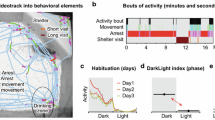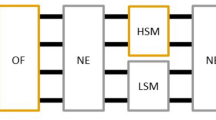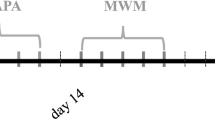Abstract
Significant differences between strains were found for open field activity and emotionality, exploratory activity, initial reaction to shock, conditioned avoidance learning, and weight for three inbred strains (Balb/c, C57Bl and C3H), such that the heaviest strain (Balb/c) was the least active and most emotional in the open field, gave the lowest score for exploratory activity and longest reaction to shock times, and was the poorest at conditioned avoidance learning.
The hybrids from crosses with C57Bl tended more towards complete dominance and overdominance than did the Balb/c × C3H hybrid, probably because the Balb/c and C3H strains have some common ancestry.
Heterosis was most marked for traits involving exploration or learning. Variability of the hybrids for these traits was often lower than the parents, i.e. they showed behavioural homeostasis. For other traits variability of the hybrids tended towards the parent whose genotype was dominant for the trait.
Of the non-genetic factors studied, age and litter size were found to have the greatest effect on the behavioural traits. Parity was found only to affect weight. Sex differences were found for weight and emotionality.
Similar content being viewed by others
References
Abeelen J. H. F.van (1966). Effects of genotype on mouse behaviour,Anim. Behav. 14: 218–225.
Barnett S. A. & S. G. Scott (1964). Behavioural “vigour” in inbred and hybrid mice.Anim. Behav. 12: 325–337.
Broadhurst P. L. & G. Bignami (1965). Correlative effects of psychogenetic selection: A study of the Roman high and low avoidance strains of rats.Behav. Res. Ther. 2: 273–280.
Bruell J. H. (1964a). Heterotic inheritance of wheel running in mice.J. Comp. Physiol. Psychol. 58: 159–163.
Bcruell J. H. (1964b). Inheritance of behavioral and physiological characters of mice and the problem of heterosis.Am. Zool. 4: 125–138.
Caspari, E. (1958). Genetic basis of behavior. InBehavior and Evolution. Eds. A. Roe and G. G. Simpson, Yale University Press pp. 103–127.
Collins R. L. (1964). Inheritance of avoidance conditioning in mice: A diallel study.Science 143: 1188–1190.
Defries J. C., J. P. Hegmann & M. W. Weir (1966). Open field behavior in mice: Evidence for a major gene effect mediated by the visual system.Science 154: 1577–1579.
Ellens A. A., A. N. Mouravieff & M. J. Heuts (1966). The age of reproduction as a factor of transmissible divergences in learning ability in the mouse.Experientia 22: 186–187.
Fuller J. L. & W. R. Thompson (1960). Behavior Genetics. John Wiley, New York.
Henderson N. D. (1967). Prior treatment effects on open field behaviour of mice—a genetic analysis.Anim. Behav. 15: 364–376.
Henry K. R. & K. Schlesinger (1967). Effects of the albino and dilute loci on mouse behavior.J. Comp. Physiol. Psychol. 63: 320–323.
Howe W. L. & P. A. Parsons (1967). Genotype and environment in the determination of minor skeletal variants and body weight in mice.J. Embryol. exp. Morph. 17: 283–292.
Jakway J. S. (1959). Inheritance of patterns of mating behaviour in the male guinea pig.Anim. Behav. 7: 150–162.
Jones M. B. (1966). On the evaluation of variability in isogenic hybrids.Biometrics 22: 623–628.
Kline, N. J. & J. Werboff (1964). Neonatal experience and later behavior in mice.Jackson Lab. 36th Annual Report, pp. 64–65.
Lerner I. M. (1954). Genetic Homeostasis. John Wiley, New York.
Levine S. (1957). Infantile experience and resistance to physiological stress.Science 126: 405.
Lieberman M. W. (1963). Early developmental stress and later behavior.Science 141: 824–825.
McClearn G. E. (1961). Genotype and mouse activity.J. Comp. Physiol. Psychol. 54: 674–676.
Oortmerssen G. A.van & J. A. Beardmore (1967). An age factor affecting variance of a behavioural character in F1 hybrids between inbred lines of the house mouse.Experientia 23: 328.
Parsons P. A. (1964). Parental age and the offspring.Quart. Rev. Biol. 39: 258–275.
Parsons P. A. (1967a). The Genetic Analysis of Behaviour. Methuen, London.
Parsons P. A. (1967b). Behavioural homeostasis in mice.Genetica 38: 134–142.
Ressler R. H. (1966). A voidance conditioning in mice: prenatal influence of mother's treatment before mating.Am. Zool. 6: 295 (Abstract).
Thompson W. R. (1953). The inheritance of behavior: behavioral differences in fifteen mouse strains.Canad. J. Psychol. 7: 145–155.
Author information
Authors and Affiliations
Rights and permissions
About this article
Cite this article
Rose, A., Parsons, P.A. Behavioural studies in different strains of mice and the problem of heterosis. Genetica 41, 65–87 (1970). https://doi.org/10.1007/BF00958895
Received:
Issue Date:
DOI: https://doi.org/10.1007/BF00958895




